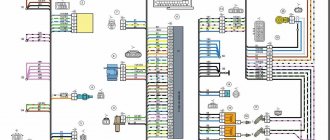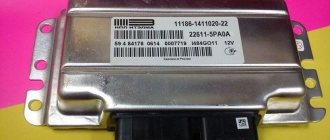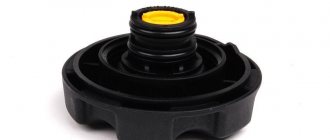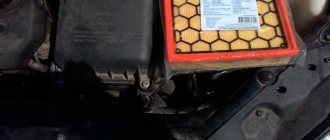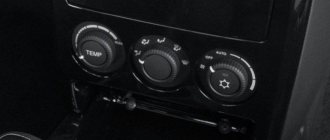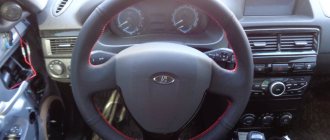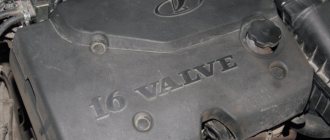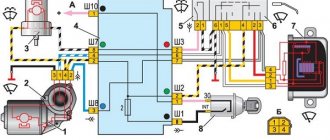“Seven” is still popular, they are bought, then sold, then bought again. This is the most advanced model of the classic Lada.
The rear window heating schemes for each car brand are different, but for models of the same family they are approximately the same. The VAZ 2107 heater circuit is simple. You should look for the reason for the intermittent or completely non-functioning glass heater in the electrical circuit diagram. Heated glass does an excellent job of preventing fogging, but it happens that the heater is working, the heating is working, but the glass in the car still sweats.
What you need to know about the air recirculation system of the Lada Priora
The vast majority of Lada Priora cars have an air recirculation button on the dashboard. On early models, this mode worked as part of the Halla climate system; later Panasonic air conditioners began to be installed on cars. Recirculation can work without an air conditioning system, but in this case its capabilities are somewhat limited, since in this case the car will no longer be able to work to lower the air temperature in the cabin.
Installation and troubleshooting of the interior air recirculation system of the Lada Priora.
- Purpose of the air recirculation system
- Air recirculation in Priora: main faults
- The damper drive does not work
Other methods and connection diagram
The largest category of cars that do not have heated mirrors, of course, are all our domestic car models, so the most pressing question for the VAZ 2112 is how to connect heated mirrors, now we will tell you the answer. So:
Installing heating is a very popular variety of tuning procedures, because it is not particularly difficult and is therefore available to every interested car owner, the connection diagram is shown in the photo below
Electrical diagram for connecting heating elements
Of course, when it is urgently necessary to do heating, then the purchase and installation of new mirror elements with a built-in heater is the most popular and most often used option
Device
The system contains
:
- Air heating distributor assembly (left and right semi-casings, heated footwells and heated windows, movable damper drive lever (drive by gear motor, five fixed positions);
- Left and right ventilation air ducts connecting the side oval windows in the distributor semi-housings with the side deflectors (manufactured using blowing technology);
- Instrument panel trim (defroster) with guide vanes;
- Heating (blowing) nozzles for side windows (demister);
- Central and side ventilation deflectors;
- Leg heating air duct (front);
- Air ducts for heating the feet of rear passengers left and right.
- Spoiler.
Pinout for left front door
Most modern vehicles are equipped with a variety of driver comfort systems, one of which is the driver's door module.
The function of the button block located on the driver's door is to control the front windows and exterior mirrors, as well as the automatic locking of the car doors. The installed auxiliary left rear wiring harness (part number 21703-724551-90) comes complete with contact carriers made of electrically conductive materials.
| Contact no. | Decoding |
| 1 | Connector for the additional rear left harness to the rear harness |
| 2 | Rear left harness connector to front left speaker |
| 3 | Electric window lift |
| 4 | Armrest control module |
| 5 | Electric drive for locking the left front door |
| 6 | Left outer rear view mirror control chip |
Fault diagnosis
If the device breaks down, experts recommend diagnostics in the following sequence:
- the ignition and engine are turned on;
- the maximum fan speed is set;
- the recirculation button is pressed;
- the valve-flap mechanism starts.
If the movement is uniform and if the damper stops at the end point, in the first 2-3 seconds, this indicates the serviceability of the complex.
But pops, uneven movement, and clicks indicate a malfunction.
To extend the service life of the complex, it is necessary to install a stabilizer. Due to the operation of the stabilizer, where the damper is located, the torque of the electric drive is reduced. To eliminate the possibility of damage to the damper for the time before purchasing a stabilizer, the damper is disconnected from the electric drive by a wire.
Fog lamp models
Kirzhach and Bosch are not a death sentence, and if the light of these models does not suit you, there is a good choice from other manufacturers:
- Automotive lighting (Ryazan);
- Beam (Ryazan);
- DAAZ;
- Orion-7 (diode);
Made in China (lensed or diode). The Chinese also sell frames for the restyled version, which are installed instead of a plug and leave a hole exactly for the old-style foglights - on the pre-restyled Priora. A non-diode or non-lensed analogue of fog lights costs much less, but you shouldn’t rush into purchasing - bright white light does not always come with a long service life.
The damper drive does not work
It is impossible to check whether the Priora recirculation valve is working (on cars with the Panasonic climate system) by viewing errors in the operation of the system - the corresponding codes are simply not provided. Therefore, it is necessary to perform the following actions in accordance with the algorithm described in the diagnostic card:
- use a multimeter to measure the voltage level between ground and contact No. 1 going to the mode switch,
- if the obtained value corresponds to the on-board network voltage, there is an open circuit in the recirculation switch section,
- otherwise, you need to measure the voltage between ground and contact No. 2 of the recirculation button when it is pressed,
- if the measured value is equal to the on-board network voltage, the switch itself is faulty, and then it must be replaced,
- otherwise, use a multimeter to measure the state of the recirculation key,
- if the value is equal to the on-board network voltage, there is an open circuit in the area between the mode activation key and the SAUKU heater controller,
- if not, proceed to measuring the voltage in the area between ground and contact No. 1 of the damper solenoid valve (the recirculation mode button must be pressed),
- if the obtained value corresponds to the on-board network voltage, there is a break in the electrical circuit in this area,
- otherwise, there will be an open circuit in the ground circuit of the damper drive valve.
The pinout of the Priora recirculation button is described in detail in the circuit diagram of the Panasonic climate control system. If the recirculation malfunction is caused not by an open circuit or a breakdown of the solenoid valve itself, but by a malfunction of the damper, replacing it can be quite difficult for an unprepared car owner.
If you go to a car service center, it will cost a pretty penny (about 10 thousand rubles), since the technicians will tell you that you need to remove the entire stove, drain the antifreeze, and also remove freon from the air conditioning system. You can do this yourself, and without draining the antifreeze and pumping out the refrigerant. Therefore, it makes sense to describe the procedure for replacing the vacuum drive if the Priora interior air recirculation damper does not work:
- To begin with, you will need an L-shaped screwdriver - it is not sold in stores, but it is not difficult to make by bending any existing one made of a fairly soft metal. We use it to unscrew the bottom screw, which is located very inconveniently - there is a hole there large enough to stick your hand through and perform the necessary manipulations,
- the top screw is hidden behind the plastic of the stove body - it needs to be drilled exactly opposite the screw,
- disconnect the damper rod, for which you need to pull it to the left with a little effort,
- now the drive is free, all that remains is to pull it out (pull it a little to the left and press in the direction of the engine compartment - it should fall down), you need to pull it out carefully, since it can cling to surrounding parts,
- the procedure for inserting a new vacuum drive is also quite tedious - first we try to insert the valve into its normal place,
- the second step is to get the drive tube into the hole located in the lower part of the heater,
- put the hose on the valve itself,
- we tighten the screws in the reverse order (you will have to tinker with the bottom one, so you don’t have to tighten it - the valve will be held quite securely even without the bottom screw).
DIY heating repair
The most common reason for heating not working is damage to thin conductive threads. Modern technologies make it possible to restore broken areas of these threads with your own hands without the involvement of specialists.
Finding the location of the thread break
First you need to find the damaged areas of the threads. The process will not take long, since the cliffs are clearly visible to the naked eye. It is extremely rare to see minor damage that is difficult to see, in which case you need to use a voltmeter.
The thread has a resistance of 10 ohms, each section has its own voltage. On the first - the voltage is twelve volts, on the third - already six, and on the fifth - zero. To search for a break, measure the voltage at the center of each element. If there is damage, the multimeter will output 12 or 0 volts, which makes it clear that there is a break on the left or right side of the thread.
Troubleshooting a heater using a copper solution
To work you will need:
- sulfuric acid;
- copper rod, diameter up to 10 mm;
- copper sulfate;
- strip of fabric 50x30 cm;
- scotch;
- scissors;
- glass cleaner.
Sulfuric acid
Copper rod
Copper sulfate
To repair damage to a conductive thread, do the following:
At the first stage, it is important to prepare the damaged surface for restoration work. To do this, use a rag soaked in alcohol and wipe the glass with it.
When the dirt is completely removed, degrease the surface. Place tape on both sides of the conductive thread at the break point. We attach the adhesive tape so that the width between the strips corresponds to the heating filament. The copper rod is wrapped with fabric at one end. We secure the so-called tassel with threads. A copper solution is being prepared. Half a glass of water is thoroughly mixed with two teaspoons of copper sulfate. A little highly concentrated sulfuric acid or electrolyte from car batteries is added to the resulting liquid. The terminals from the heating device are connected to ground. The wire from the positive terminal of the battery is connected to a previously made brush made of a metal rod. The resulting electrode, soaked in the solution, carefully rubs the areas of broken threads. The ends of serious breaks are pre-processed using an electric soldering iron. He also installs a connecting jumper made of the thinnest wire. As a result, slightly damaged areas are covered with copper.
Troubleshooting a Heater with Conductive Adhesive
Conductive glue is a specialized paste that contains fine powder of palladium, as well as nickel gold or silver. Thanks to the listed elements, this substance conducts current perfectly and has good connecting properties. The process of restoring the stern glass heating filaments using conductive glue is faster and more efficient.
To begin restoring the threads, we perform the same procedures of cleaning the glass surface and covering the damaged area with tape. To prepare conductive glue, repair kits contain two substances that should be thoroughly mixed in a separate container. How to prepare the composition and subsequently use it for its intended purpose is written in the instructions on the package.
We recommend: Signs of a faulty automatic transmission control unit. Helpful information
The glue is applied using a brush or a cotton swab; the layer size should not exceed 2 mm. The average hardening time of the conductive composition is 30 minutes. After 24 hours, remove excess substance; this is done using a knife or any sharp object.
When removing excess conductive adhesive, you must act extremely carefully, otherwise the surface of the heating device will be damaged again.
How to disarm the electrical package unit of LADA PRIORA
What to do if Priora is not removed from the standard alarm!
The hazard warning light blinks, the car does not respond to the ignition key buttons. As a rule, several units are involved here that are synchronized with each other.
- Ignition
- Radio channel module (Located in the driver's door)
- Electrical package block (Comfort block)
- Engine ECU
New blocks come with non-activated codes inside and can be installed on any car without problems, but once you register (train) the keys, a special code is written into all these blocks, which is synchronized with each other and serves as a standard alarm system. (Immobilizer) As soon as you turn the ignition key, within five seconds there is a poll between the key and the units, if the code matches everywhere, then the engine ECU gives permission to start, if the code of at least one device is not recognized, the engine ECU is blocked and the car does not start.
Training a working key is done using a special red training key. I will not describe the procedure for training keys; there is plenty of information on the Internet. In fact, the main key is a red training key; it stores a code that, after training, is written into the working key and other blocks.
I'll try to explain in more detail how it all works:
- The radio channel code that we use to open doors using the key's remote control buttons is written into the driver's door module, where the power window buttons are located. If you replace the comfort unit or engine ECU, the buttons on the key will still work.
- The IMMO (Immobilizer) code has a connection only with the ignition key, the electrical package unit and the ECU unit. If you disconnect the driver's door module, the car will still start.
How to determine whether the keys are trained or not:
- The IMMO lamp on the instrument panel goes out after 5 seconds - the keys are trained.
- The IMMO lamp goes out after 30 seconds - the keys are not trained. (The car will start with any blank)
Options for disabling IMMO:
Write an untrained eeprom dump to the engine ECU. All functions will remain working as normal, key buttons, etc., only the car will start with any blank.
If the vehicle cannot be disarmed using the remote control:
- Here the situation is a little more complicated, this is why this article was written. Suddenly, for some reason, the car remained on guard, the hazard lights blink, the car beeps, etc. Of course, you will open the car mechanically using the keyhole in the door, but at the same time constantly The hazard warning lights blink and the comfort functions do not work, and the car does not start. The reason could be a breakdown of the remote control key or the driver's door module. However, the electrical package unit remained armed.
- There are two ways to disarm the electrical package unit: 1) Install the driver's door module from another car and open it remotely from the key of the same car. In this way, you can disarm the comfort unit. 2) Disassemble the electrical package unit and use the programmer to clean the M95080 memory chip.
Comfort unit, disarming. This instruction applies only to unlocking the electrical package unit. If you need to unblock the engine starting, it is enough to write an unlearned eprom dump into the engine ECU.
We disassemble the block and find the memory chip eeprm M95080. It is enough to insert this chip into the programmer and completely clean it, or replace it with a new one if there is no programmer. When re-learning the keys, all the necessary data will be written into it again.
After cleaning the microcircuit, the electrical package unit will disarm.
A few more photos on the topic and video.
Pinout of the comfort block for connection on the table.
Electric package controller connection diagram.
Fuse box in the passenger compartment of VAZ-2170, -2171, -2172
The fuse box in Priora is located at the bottom of the dashboard, on the left side of the steering wheel. To get to it, you need to open the cover, which is held on by three latches. Rotate each locking knob 90 degrees and pull the lid down and it will snap open.
Fuses in the interior mounting block
F1 (25 A) - radiator cooling fan . If your fan does not work, check its motor by applying 12 V directly to it from the battery. If the engine is working properly, then most likely the problem is in the wiring or connectors. Check the serviceability of relay K1.
The fan in the Priora usually turns on at a temperature of 105-110 degrees. Do not allow the engine to overheat, watch the arrow of the temperature sensor.
If the fan runs constantly and does not turn off, check the coolant temperature sensor located on the thermostat. If you remove the connector from the working sensor, the fan should turn on. Check the wiring to this temperature sensor, as well as the contacts of relay K1, move this relay, clean the contacts. If this is the case, replace it with a new relay.
F2 (25 A) - heated rear window . Check together with fuse F11 and relay K2. If the rear window does not fog up, the heating element threads may have broken. Inspect all the threads and if you find a break, seal it with special glue or varnish, which can be bought at car dealerships for 200-300 rubles. Check the connection contacts at the terminals to the heating elements at the edges of the glass, as well as the switch on the dashboard and the wiring from it to the rear window.
F3 (10 A) - high beam, right headlight . F4 (10 A) - high beam, left headlight . If the headlights do not shine on high beam, check the K7 relay and the headlight bulbs. The steering column switch, wiring or connectors may also be faulty.
F5 (10 A) - sound signal.
If the signal does not work when you press the steering wheel button, check relay K8. The signal itself is located under the radiator grille; you can get to it by removing the plastic casing from above. Check it by connecting the voltage to 12 V. If it doesn’t work, try turning the adjusting screw, or replace it with a new one.
F6 (7.5 A) - low beam, left headlight . F7 (7.5 A) - low beam, right headlight . When replacing lamps, be careful; there are separate lamps for the low and high beams, so they can be easily confused. It is better not to install lamps in high-power headlights; the reflectors may melt and the desired effect will not be achieved. Most low beam headlight problems that cannot be corrected by conventional means can be related to the light control module (LCM). The low beam relay is only available in cars equipped with a light sensor, it is located in the place of relay K1; on most cars this relay is not in the mounting block; the low beam circuit goes through the MUS block. It happens that the tracks in the block burn out; if there are problems, it is better to replace it with a new one. If the windshield wipers turn on spontaneously when the low beam is not working correctly, the problem is most likely in the windshield wiper control unit, located in the center of the dashboard, the topmost block, next to the radio, is best reached from the glove compartment, or by hand through the removed console covers at the feet.
Description of the electrical package control unit
The electrical package controller in Priora is a device used to control the functionality of the vehicle. This unit is responsible for the operation of turn signals, power windows, control panel lighting, dimensions, fog lights, interior lighting, and rear window heating system. This device also ensures the normal operation of the reversing lights. The fact that the car is equipped with this device makes it even more practical.
Priorovsky electrical package control controller
Location
The control device on the Priora is located above the electronic engine control unit, at the bottom of the center console, in the middle. In this case, the device is connected using two connectors - power and information. The power output is used to supply voltage to the control unit, and the information output is used to perform the functions of the device. It should also be noted that the control unit is protected from external influences of dirt and moisture.
Rear license plate light pinout
According to traffic regulations, the state license plate illumination must always be in working order. For lighting, W5W incandescent lamps are connected, each with a power of 5 W.
The small wiring harness for the rear license plate light (harness serial number 2170-3724214) consists of wires with cream ends and is located in the luggage compartment. The operation of the entire lighting system depends on its quality. The harness responsible for the rear license plate illumination has 3 terminals:
| № | Decoding |
| 1 | Supplying voltage to the lights illuminating the rear number |
| 2,3 | License plate lamps |
| 4 | Electric tailgate lock motor |
Purpose of the air recirculation system
How is the recirculation mode useful? Firstly, it ensures a much faster establishment of the optimal temperature inside the car, especially after the car has been parked for a long time. This is achieved due to the fact that the intake of external air stops. Consequently, only the air that circulates through the heating or air conditioning system is involved in the blowing process. Accordingly, it does not cool in winter and does not heat up in summer due to mixing with the external flow, that is, its temperature almost immediately becomes optimal.
Secondly, if it is necessary to cool the cabin in the hot season, the energy consumption for operating the evaporator in recirculation mode becomes half as much as when using the oncoming external flow.
Thirdly, the mode for blocking the air intake from outside is very useful in cases where conditions outside are far from ideal in terms of the presence of various contaminants and unpleasant odors in the air. Such factors, for example, could be:
- driving on country roads with no hard surface - on such roads in the summer there is a column of dust, and any oncoming car threatens to turn the air in the cabin, even with the windows completely closed, into a dense suspension, which becomes impossible to breathe,
- driving in a traffic jam, when the virtual absence of dynamics and dense traffic lead to multiple concentrations of exhaust gases freely penetrating into the cabin,
- driving past sources of unpleasant odors - for example, a cow barn, pig farm, poultry farm, landfill or industrial complex with specific odors,
- movement in long tunnels in conditions of traffic jam speed, when stagnation phenomena greatly increase the concentration of exhaust,
- if foul-smelling or polluted outside air has already leaked into the cabin, and it’s still a long way from leaving for a clean zone, turning on internal recirculation will also be useful - the bad air is usually cleared quite quickly.
Note that, despite such useful features of the Priora’s air recirculation mode, its use should not be long-term, since there is no air exchange. This leads to a decrease in the amount of oxygen and a corresponding increase in the concentration of carbon dioxide. The latter, as is known, has a suffocating effect on the body, causing drowsiness in the driver and passengers. Therefore, long driving (more than 15 minutes) in this mode is not recommended, since it has a bad effect on people’s well-being.
The second negative point is that if you breathe the same air for a long time, it becomes saturated with moisture, which is abundantly present in a person’s exhalation. And if, in addition to the driver, there are also passengers in the car, an increase in air humidity leads to rapid fogging of the windows, which even the turned on air conditioner cannot cope with. From a physics point of view, fogging is the result of exceeding the concentration of moisture in the air, the so-called “dew point,” especially in the area of the windshield, which always has a temperature lower than in the cabin. For this reason, climate systems in the “defrost” mode (defrosting the windows) automatically block the recirculation of cabin air.
When is it not a good idea to restore the heated rear window of a car with your own hands?
Repairing heated glass is impractical in three cases:
A large number of damaged threads
- If the number of thread damages and breaks is too much. For example, when almost all the threads are damaged, also in several places, and the gaps are large. In this case, the chances of success are seriously reduced.
- If the thread breaks are too large. There is no consensus here, but the chances that you will be able to restore damage longer than 5 and especially 10 centimeters are very small. In addition, very large restored areas will negatively affect operation in the winter when you turn on the system to remove ice. In restored areas, the heating will be several times stronger and such a difference can lead to the glass bursting.
- If you need to remove the tint to repair damaged threads, especially when there are a lot of breaks. When dismantling the tint, you can damage the threads even more and it will be impossible to restore them entirely.
All of the above advice can be considered purely advisory and you can always test your strength in these difficult cases. However, sometimes it is really easier to replace the entire glass rather than waste time and money on searches and repairs. Since a kit for repairing rear window heating filaments also costs money.
Device principle
Next, let’s look at the Panasonic air conditioner circuit, which consists of the following components:
- The compressor is a single-pass rotary with three blades. This element builds up the required pressure and maintains the circulation of the refrigerant. The compressor is located under the generator.
- A condenser is a heat exchanger that provides cooling to a gaseous refrigerant by turning it into a liquid state. This mechanism is located on the radiator frame.
- The evaporator is also a heat exchanger; its purpose is to cool and dry the air before it enters the cabin. This device is located in the heater housing.
- The receiver has the shape of a metal cylinder, which is connected to the capacitor. This mechanism ensures the accumulation of liquid refrigerant and separation of moisture and debris. There is a filter drier inside the receiver.
- Pipelines.
Adjusting the heater damper
Sometimes the reason that the car interior remains cold is that the heater damper does not open, despite the fact that the gear motor is trying to turn it to the desired position. In most cases, the damper regulator, which is responsible for setting it to the desired position, is to blame.
This is possible on the heater dampers both with and without air conditioning due to a clogged cabin filter, which needs to be changed in a timely manner. Dust and leaves prevent the damper mechanism from opening normally.
Another reason is that the thin plastic of the damper simply warps at high temperatures in the heating line, and it stops reaching the desired position. As a result, the stove does not switch to different modes or the flows are distributed unevenly. Most often, the damper regulator remains in the “in the face” position, but the glass does not blow.
If the damper does not switch, you can remove the panel between the driver and passenger seats; it is located directly behind the central heater grilles. Sometimes you just need to change the seal to which it is pressed, or remove debris that has accumulated in it. After this, you need to check the heater damper in operation and you can assemble the panel.
If there are problems with the damper switching mechanism, you need to remove the plastic on the dashboard near the driver’s right foot. If the plastic damper is deformed, it can be replaced, but it is better to do this under warranty. In this case, repair of the stove damper on Priora is limited to treating the mechanism with VD aerosol lubricant. This can be done blindly, without removing the remaining parts of the dashboard, by feeling the switching mechanism with your hand.
After this, the damper is adjusted by simply switching it to different positions and controlling the movement with your hand under the plastic. In the vast majority of cases, this is enough for the stove to work normally again. After this, install the plastic dashboard in place and secure it with self-tapping screws.
Video: Priora stove. Diagnosis of heater malfunction
Principle of operation
In addition, the Priora heater device includes important components, without which normal operation of the stove would be impossible. These include the following mechanisms:
- The operation of the control unit is based on turning the knobs, each of which is responsible for one or another system parameter.
- The cabin temperature sensor allows you to maintain the required temperature at a constant level. This mechanism is located in the headliner trim.
- The additional resistor is located in the fan housing along with the fan, radiator, filter and damper.
- The radiator is connected through hoses to the system that cools the engine. During vehicle operation, coolant circulates from the engine to the radiator all the time. The heater is controlled by a damper, which changes the direction of outside air, directing it towards or past the radiator. The damper can be located in an intermediate position, which provides for the division of the external air flow: one part is directed to the radiator, and the other passes past it.
- The micromotor is responsible for controlling the movement of the damper. It is located on the left side of the body. The micromotor gearbox has an output shaft, which is connected to the axis on the damper.
This is exactly what the Priora stove (2020) is designed like. But we have not yet considered all working issues.
Operating principle of the air conditioner
In a sealed air conditioning system, a refrigerant, freon, continuously circulates, which is mixed with a special lubricant that is resistant to freezing. A compressor is responsible for moving freon through the system, which builds up pressure in the heat pipes. After turning on the air conditioner, freon ends up in the heat exchanger located under the dashboard of the car. The internal structure of this device resembles a honeycomb. Once there, the refrigerant begins to take heat from the hot interior. At the same time, it quickly heats up and turns from a liquid into steam. Since the compressor continuously pumps up pressure in the system, the steam goes into the blown radiator, where it cools, again becoming a liquid, which again ends up in the heat exchanger.
Is it possible to install air conditioning on a Priora?
The Priora initially provides the design possibility of installing an air conditioner. A car owner who decides to install this device on his car will not have to make any modifications. All the necessary holes and buttons are already on the dashboard, and space for heat pipes and electrical wiring is also provided. Thus, installing an air conditioner on a Lada Priora is completely legal, and government officials will not have any questions for the driver.
Heated windshield
Over time, warming up your car in winter and clearing snow and ice can get tired. How much incredible effort needs to be put into this, and besides, the surface of the windshield will be covered with microcracks due to the harsh impact of the scraper. It is worth considering a “softer” way to clear the car of snow and ice - if the windshield on the Priora is heated. In this case, all the frozen water will melt and you will not need to get out of the car to clean the surface yourself.
There are other options for the Priora from which you can choose, it all depends on your preferences, even for example green auto glass, if that suits you best.
